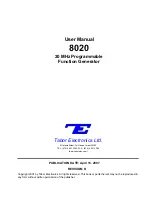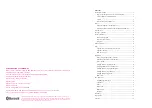
Updating the Status System and VXIbus Interrupts
The driver needs to update the Status systems information whenever the
status of the HP E1313/E1413 changes. This update is always done when
the Status system is accessed, or when
CALibrate:
…
,
INITiate:
…
, or
ABORt
commands are executed. Most of the bits in the Operation and Questionable
Registers represent conditions which can change while the HP E1313/E1413
is measuring (initiated). In many circumstances it is sufficient to have the
Status system bits updated the next time the Status system is accessed, or the
INITiate:
…
or
ABORt
commands are given. When it is desired to have the
Status system bits updated closer in time to when the condition changes on
the HP E1313/E1413, the HP E1313/E1413 interrupts can be used.
The HP E1313/E1413 can send VXIbus interrupts upon the following
conditions:
–
Trigger too Fast condition is detected. Trigger comes prior to trigger
system being ready to receive trigger.
–
FIFO overflowed. In either FIFO mode, data was received after the
FIFO was full.
–
Overvoltage detection on input. If the input protection jumper has
not been cut, the input relays have all been opened, and a
*RST
is
required to reset the HP E1313/E1413.
–
Scan complete. The HP E1313/E1413 has finished a scan list.
–
SCP trigger. A trigger was received from an SCP.
–
FIFO half full. The FIFO contains at least 32768 readings.
–
Limit Test was exceeded.
–
Measurement complete. The trigger system exited the
“ wait-for-arm” state and is checking for
INITiate:CONTinuous
.
This clears the Measuring bit in the Operation Register.
These HP E1313/E1413 interrupts are not always enabled since, under some
circumstances, this could be detrimental to the users system operation. For
example, the scan complete, SCP triggers, FIFO half full, and measurement
complete interrupts could come repetitively, at rates that would cause the
operating system to be swamped processing interrupts. In the C-SCPI
environment, there are times when interrupts from the HP E1313/E1413
could cause problems with system function calls, as described in the C-SCPI
User’s Guide. These conditions are dependent upon the user’s overall
system design, therefore the driver allows the user to decide which, if any,
interrupts will be enabled.
The way the user controls which interrupts will be enabled is via the
*OPC
,
STATus:OPERation:ENABle
,
STATus:QUEStionable:ENABle
, and
STATus:PRESet
commands.
Chapter 4
Understanding the HP E1313/E1413 129
Artisan Technology Group - Quality Instrumentation ... Guaranteed | (888) 88-SOURCE | www.artisantg.com
















































